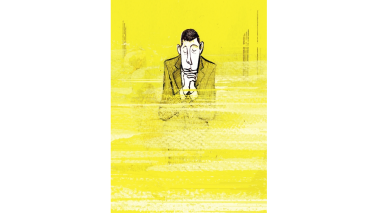Here’s my hot prediction for 2009: house price inflation at 10 per cent. Yes, that is a 10 per cent increase, and yes, I do mean 2009. Halifax figures for the year to November were still showing prices down by 1.6 per cent — but believe me, by the end of this month housing will be showing double-digit growth.
To be honest, this is not really a prediction: the 10 per cent increase in property prices across the country is already in the bag. While the statisticians at Halifax and Nationwide have been reporting annual falls in the market, their raw data shows a full-blown boom. The last year when prices rose by 10 per cent or more was 2004 and they collapsed by nearly 19 per cent in 2008, according to Halifax. The reason annualised rates can still be negative now is that the market turned in the spring and the price plunge in the early part of the past year still more than offsets a remarkable recent recovery. Nationwide’s annualised rate has just turned positive; as the months of falling prices drop out of the calculation, Halifax’s will follow and rates will very quickly soar towards 10 per cent.
The turn in the market — at much the same time as the stockmarket bears became bulls too — surprised not only the lenders but the sellers too. After a decade-long boom when would-be buyers were increasingly priced out of the market, followed by a steep slump when no one wanted to purchase an asset that was plunging in value, potential purchasers decided interest rates and prices had become too low to miss. But sellers were not so swift: stories of slow sales and constant cuts in asking prices had made owners reluctant to put their homes on the market.
The result was an increasing number of buyers competing for a shrinking stock of homes. That old definition of inflation — too much money chasing too few goods — proved true. When only one vaguely interested buyer viewed a house, he or she could haggle the price down; but once two turned up, the owner could hold an auction. It may be too early to talk of gazumping, but the return to a competitive market has certainly perked prices.
Low interest rates not only encouraged people to borrow, they stimulated savers to seek a more profitable place to put their money. Housing, like shares, has been the beneficiary — and the Bank of Mum and Dad, closed since the credit crunch, has resumed the financing of offspring’s property purchases. The official lenders are keener to give loans too, advancing a greater proportion of the price now they think the value of their collateral won’t fall further. Lending is still below pre-crunch levels but it has doubled over the past year and lack of finance is no longer an excuse for not buying.
Rising values are one reason why forecasts of repossessions have been sharply reduced too — and account for the revival of buy-to-let. And once a market starts moving it can provide its own momentum, either accelerating the trend or correcting it. In the early stages, signs of increasing prices bring more prospective purchasers into the market and embolden wavering buyers to bid, thus pushing values higher still. However, sooner or later, would-be sellers will see what is happening and increase the supply of properties, thus dampening the excess demand.
So the 10 per cent rise since February that Nationwide’s December figures will show (Halifax’s prices bottomed in April with an 18 per cent annual fall, but a year later that should be a double-digit rise too) may be the peak rate for housing inflation for now. Even if prices keep rising, the percentage gain will slip, but some even think actual prices will fall again, turning the V-shaped recovery into a W as fears for the economy take hold.
Clouds on the horizon include this month’s end of the stamp-duty holiday on homes below £175,000 as well as rising unemployment and higher taxes. Property markets tend to close down for general elections and World Cups, and we have both in 2010. But if sellers wait for the Tories to cancel the hated Home Information Packs, as promised, the shortage of stock could continue and the consensus is that mortgage rates will remain low for another year.
While this year’s boom is still hidden in the statistics, it shows this was a short sharp housing recession compared with the drawn-out depression of the last decade. Prices fell only 13 per cent in the 1990s crash compared with 23 per cent this time, but the decline dragged on for more than six years compared with just 18 months in 2007-09. A 10 per cent recovery took nearly two years last time, only nine months this time. But the property peak of 2007 was high and it will take a long climb to return there. We’ve mounted only the first steps of the long staircase to recovery.




Comments